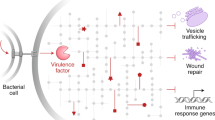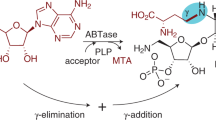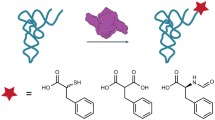Abstract
Ribosome stalling at polyproline stretches is common and fundamental. In bacteria, translation elongation factor P (EF-P) rescues such stalled ribosomes, but only when it is post-translationally activated. In Escherichia coli, activation of EF-P is achieved by (R)-β-lysinylation and hydroxylation of a conserved lysine. Here we have unveiled a markedly different modification strategy in which a conserved arginine of EF-P is rhamnosylated by a glycosyltransferase (EarP) using dTDP-L-rhamnose as a substrate. This is to our knowledge the first report of N-linked protein glycosylation on arginine in bacteria and the first example in which a glycosylated side chain of a translation elongation factor is essential for function. Arginine-rhamnosylation of EF-P also occurs in clinically relevant bacteria such as Pseudomonas aeruginosa. We demonstrate that the modification is needed to develop pathogenicity, making EarP and dTDP-L-rhamnose–biosynthesizing enzymes ideal targets for antibiotic development.
This is a preview of subscription content, access via your institution
Access options
Subscribe to this journal
Receive 12 print issues and online access
$259.00 per year
only $21.58 per issue
Buy this article
- Purchase on Springer Link
- Instant access to full article PDF
Prices may be subject to local taxes which are calculated during checkout





Similar content being viewed by others
Change history
24 February 2015
In the version of this article initially published online, the second author's middle initial was inadvertently omitted. The error has been corrected for the print, PDF and HTML versions of this article.
References
Tanner, D.R., Cariello, D.A., Woolstenhulme, C.J., Broadbent, M.A. & Buskirk, A.R. Genetic identification of nascent peptides that induce ribosome stalling. J. Biol. Chem. 284, 34809–34818 (2009).
Woolstenhulme, C.J. et al. Nascent peptides that block protein synthesis in bacteria. Proc. Natl. Acad. Sci. USA 110, E878–E887 (2013).
Peil, L. et al. Distinct XPPX sequence motifs induce ribosome stalling, which is rescued by the translation elongation factor EF-P. Proc. Natl. Acad. Sci. USA 110, 15265–15270 (2013).
Hersch, S.J. et al. Divergent protein motifs direct elongation factor P–mediated translational regulation in Salmonella enterica and Escherichia coli. mBio 4, e00180–e00113 (2013).
Elgamal, S. et al. EF-P dependent pauses integrate proximal and distal signals during translation. PLoS Genet. 10, e1004553 (2014).
Starosta, A.L. et al. Translational stalling at polyproline stretches is modulated by the sequence context upstream of the stall site. Nucleic Acids Res. 42, 10711–10719 (2014).
Ude, S. et al. Translation elongation factor EF-P alleviates ribosome stalling at polyproline stretches. Science 339, 82–85 (2013).
Doerfel, L.K. et al. EF-P is essential for rapid synthesis of proteins containing consecutive proline residues. Science 339, 85–88 (2013).
Gutierrez, E. et al. eIF5A promotes translation of polyproline motifs. Mol. Cell 51, 35–45 (2013).
Saini, P., Eyler, D.E., Green, R. & Dever, T.E. Hypusine-containing protein eIF5A promotes translation elongation. Nature 459, 118–121 (2009).
Hanawa-Suetsugu, K. et al. Crystal structure of elongation factor P from Thermus thermophilus HB8. Proc. Natl. Acad. Sci. USA 101, 9595–9600 (2004).
Blaha, G., Stanley, R.E. & Steitz, T.A. Formation of the first peptide bond: the structure of EF-P bound to the 70S ribosome. Science 325, 966–970 (2009).
Park, M.H., Cooper, H.L. & Folk, J.E. Identification of hypusine, an unusual amino acid, in a protein from human lymphocytes and of spermidine as its biosynthetic precursor. Proc. Natl. Acad. Sci. USA 78, 2869–2873 (1981).
Park, M.H., Cooper, H.L. & Folk, J.E. The biosynthesis of protein-bound hypusine (N-ɛ-(4-amino-2-hydroxybutyl)lysine). Lysine as the amino acid precursor and the intermediate role of deoxyhypusine (N-ɛ-(4-aminobutyl)lysine). J. Biol. Chem. 257, 7217–7222 (1982).
Cooper, H.L., Park, M.H., Folk, J.E., Safer, B. & Braverman, R. Identification of the hypusine-containing protein hy+ as translation initiation factor eIF-4D. Proc. Natl. Acad. Sci. USA 80, 1854–1857 (1983).
Navarre, W.W. et al. PoxA, YjeK, and elongation factor P coordinately modulate virulence and drug resistance in Salmonella enterica. Mol. Cell 39, 209–221 (2010).
Gilreath, M.S. et al. β-Lysine discrimination by lysyl-tRNA synthetase. FEBS Lett. 585, 3284–3288 (2011).
Yanagisawa, T., Sumida, T., Ishii, R., Takemoto, C. & Yokoyama, S. A paralog of lysyl-tRNA synthetase aminoacylates a conserved lysine residue in translation elongation factor P. Nat. Struct. Mol. Biol. 17, 1136–1143 (2010).
Peil, L. et al. Lys34 of translation elongation factor EF-P is hydroxylated by YfcM. Nat. Chem. Biol. 8, 695–697 (2012).
Bailly, M. & de Crecy-Lagard, V. Predicting the pathway involved in post-translational modification of elongation factor P in a subset of bacterial species. Biol. Direct 5, 3 (2010).
Bullwinkle, T.J. et al. (R)-β-Lysine–modified elongation factor P functions in translation elongation. J. Biol. Chem. 288, 4416–4423 (2013).
Franceschini, A. et al. STRING v9.1: protein-protein interaction networks, with increased coverage and integration. Nucleic Acids Res. 41, D808–D815 (2013).
Hau, H.H. & Gralnick, J.A. Ecology and biotechnology of the genus Shewanella. Annu. Rev. Microbiol. 61, 237–258 (2007).
Fredrickson, J.K. et al. Towards environmental systems biology of Shewanella. Nat. Rev. Microbiol. 6, 592–603 (2008).
Peng, W.T., Banta, L.M., Charles, T.C. & Nester, E.W. The chvH locus of Agrobacterium encodes a homologue of an elongation factor involved in protein synthesis. J. Bacteriol. 183, 36–45 (2001).
Haneburger, I., Eichinger, A., Skerra, A. & Jung, K. New insights into the signaling mechanism of the pH-responsive, membrane-integrated transcriptional activator CadC of Escherichia coli. J. Biol. Chem. 286, 10681–10689 (2011).
Cox, J. & Mann, M. MaxQuant enables high peptide identification rates, individualized p.p.b.-range mass accuracies and proteome-wide protein quantification. Nat. Biotechnol. 26, 1367–1372 (2008).
Mäki, M. & Renkonen, R. Biosynthesis of 6-deoxyhexose glycans in bacteria. Glycobiology 14, 1R–15R (2004).
Jimenez, P.N. et al. The multiple signaling systems regulating virulence in Pseudomonas aeruginosa. Microbiol. Mol. Biol. Rev. 76, 46–65 (2012).
Singh, D.G. et al. β-Glucosylarginine: a new glucose-protein bond in a self-glucosylating protein from sweet corn. FEBS Lett. 376, 61–64 (1995).
Li, S. et al. Pathogen blocks host death receptor signalling by arginine GlcNAcylation of death domains. Nature 501, 242–246 (2013).
Pearson, J.S. et al. A type III effector antagonizes death receptor signalling during bacterial gut infection. Nature 501, 247–251 (2013).
Eddy, S.R. A new generation of homology search tools based on probabilistic inference. Genome. Inform. 23, 205–211 (2009).
Katoh, K., Kuma, K., Toh, H. & Miyata, T. MAFFT version 5: improvement in accuracy of multiple sequence alignment. Nucleic Acids Res. 33, 511–518 (2005).
Camacho, C. et al. BLAST+: architecture and applications. BMC Bioinformatics 10, 421 (2009).
Price, M.N., Dehal, P.S. & Arkin, A.P. FastTree 2—approximately maximum-likelihood trees for large alignments. PLoS ONE 5, e9490 (2010).
Crooks, G.E., Hon, G., Chandonia, J.M. & Brenner, S.E. WebLogo: a sequence logo generator. Genome Res. 14, 1188–1190 (2004).
Keilberg, D., Wuichet, K., Drescher, F. & Sogaard-Andersen, L. A response regulator interfaces between the Frz chemosensory system and the MglA/MglB GTPase/GAP module to regulate polarity in Myxococcus xanthus. PLoS Genet. 8, e1002951 (2012).
Punta, M. et al. The Pfam protein families database. Nucleic Acids Res. 40, D290–D301 (2012).
Jacobs, M.A. et al. Comprehensive transposon mutant library of Pseudomonas aeruginosa. Proc. Natl. Acad. Sci. USA 100, 14339–14344 (2003).
Schmidt, J. et al. The Pseudomonas aeruginosa chemotaxis methyltransferase CheR1 impacts on bacterial surface sampling. PLoS ONE 6, e18184 (2011).
Heermann, R., Zeppenfeld, T. & Jung, K. Simple generation of site-directed point mutations in the Escherichia coli chromosome using Red®/ET® Recombination. Microb. Cell Fact. 7, 14 (2008).
Lassak, J., Henche, A.L., Binnenkade, L. & Thormann, K.M. ArcS, the cognate sensor kinase in an atypical Arc system of Shewanella oneidensis MR-1. Appl. Environ. Microbiol. 76, 3263–3274 (2010).
Ho, S.N., Hunt, H.D., Horton, R.M., Pullen, J.K. & Pease, L.R. Site-directed mutagenesis by overlap extension using the polymerase chain reaction. Gene 77, 51–59 (1989).
Bertani, G. Studies on lysogenesis. I. The mode of phage liberation by lysogenic Escherichia coli. J. Bacteriol. 62, 293–300 (1951).
Rappsilber, J., Mann, M. & Ishihama, Y. Protocol for micro-purification, enrichment, pre-fractionation and storage of peptides for proteomics using StageTips. Nat. Protoc. 2, 1896–1906 (2007).
Cox, J. et al. Andromeda: a peptide search engine integrated into the MaxQuant environment. J. Proteome Res. 10, 1794–1805 (2011).
Neuhauser, N., Michalski, A., Cox, J. & Mann, M. Expert system for computer-assisted annotation of MS/MS spectra. Mol. Cell. Proteomics 11, 1500–1509 (2012).
Kharel, M.K., Lian, H. & Rohr, J. Characterization of the TDP-d-ravidosamine biosynthetic pathway: one-pot enzymatic synthesis of TDP-d-ravidosamine from thymidine-5-phosphate and glucose-1-phosphate. Org. Biomol. Chem. 9, 1799–1808 (2011).
Wang, G. et al. Cooperation of two bifunctional enzymes in the biosynthesis and attachment of deoxysugars of the antitumor antibiotic mithramycin. Angew. Chem. Int. Edn. Engl. 51, 10638–10642 (2012).
Wang, G., Kharel, M.K., Pahari, P. & Rohr, J. Investigating mithramycin deoxysugar biosynthesis: enzymatic total synthesis of TDP-d-olivose. ChemBioChem 12, 2568–2571 (2011).
Gödeke, J., Pustelny, C. & Haussler, S. Recycling of peptidyl-tRNAs by peptidyl-tRNA hydrolase counteracts azithromycin-mediated effects on Pseudomonas aeruginosa. Antimicrob. Agents Chemother. 57, 1617–1624 (2013).
Haid, S., Windisch, M.P., Bartenschlager, R. & Pietschmann, T. Mouse-specific residues of claudin-1 limit hepatitis C virus genotype 2a infection in a human hepatocyte cell line. J. Virol. 84, 964–975 (2010).
Gentzsch, J. et al. Hepatitis C virus complete life cycle screen for identification of small molecules with pro- or antiviral activity. Antiviral Res. 89, 136–148 (2011).
Essar, D.W., Eberly, L., Hadero, A. & Crawford, I.P. Identification and characterization of genes for a second anthranilate synthase in Pseudomonas aeruginosa: interchangeability of the two anthranilate synthases and evolutionary implications. J. Bacteriol. 172, 884–900 (1990).
Wilhelm, S., Gdynia, A., Tielen, P., Rosenau, F. & Jaeger, K.E. The autotransporter esterase EstA of Pseudomonas aeruginosa is required for rhamnolipid production, cell motility, and biofilm formation. J. Bacteriol. 189, 6695–6703 (2007).
Ochsner, U.A., Koch, A.K., Fiechter, A. & Reiser, J. Isolation and characterization of a regulatory gene affecting rhamnolipid biosurfactant synthesis in Pseudomonas aeruginosa. J. Bacteriol. 176, 2044–2054 (1994).
Emsley, P. & Cowtan, K. Coot: model-building tools for molecular graphics. Acta Crystallogr. D Biol. Crystallogr. 60, 2126–2132 (2004).
Acknowledgements
We would like to thank I. Weitl for excellent technical assistance. This work was supported by the Deutsche Forschungsgemeinschaft: Center for Integrated Protein Science Munich (CiPSM; Exc114/2 to K.J. and WI3285/4-1 to D.N.W.) and the Max Planck Society (to E.C.K., K.W., L.S.-A. and M.M.). A.L.S. is funded by an AXA Research Fund Postdoctoral Fellowship. The work of S.H. and J.G. was supported by the Helmholtz Association and the Bundesministerium für Bildung und Forschung. J.-M.C. and J.R are funded by the US National Institutes of Health (CA 091901).
Author information
Authors and Affiliations
Contributions
J.L. and K.J. designed the experiments and wrote the manuscript. J.L., A.L.S. and D.N.W. discovered EarP and arginine-type EF-P using bioinformatics. K.W., J.L. and L.S.-A. performed phylogenetic analyses. J.L. and M.F. generated S. oneidensis and E. coli deletion mutants as well as all of the plasmids used in the study. All phenotypic analysis was performed by J.L. and M.F. J.L. purified proteins for MS analysis, which was performed by E.C.K. and analyzed by E.C.K. and M.M. TDP-L-rhamnose was synthesized by J.-M.C. and J.R. for in vitro glycosylation performed by J.L. Modeling of modified EF-P to the ribosome was done by D.N.W. Phenotypic characterization of P. aeruginosa Δefp and ΔearP mutants was performed by J.G. and analyzed by J.G. and S.H.
Corresponding authors
Ethics declarations
Competing interests
The authors declare no competing financial interests.
Supplementary information
Supplementary Text and Figures
Supplementary Results, Supplementary Figures 1–12 and Supplementary Tables 1–4. (PDF 3661 kb)
Supplementary Data Set 1
Distribution of EF-P, EpmA, EpmB, EpmC, EarP, and RmlD homologs in the representative genome set (XLS 189 kb)
Supplementary Data Set 2
EF-P, EpmA, EpmB, EpmC, EarP, and RmlD sequences identified in the representative genome set. (XLS 141 kb)
Rights and permissions
About this article
Cite this article
Lassak, J., Keilhauer, E., Fürst, M. et al. Arginine-rhamnosylation as new strategy to activate translation elongation factor P. Nat Chem Biol 11, 266–270 (2015). https://doi.org/10.1038/nchembio.1751
Received:
Accepted:
Published:
Issue Date:
DOI: https://doi.org/10.1038/nchembio.1751
This article is cited by
-
Translation stalling proline motifs are enriched in slow-growing, thermophilic, and multicellular bacteria
The ISME Journal (2022)
-
Cyclic immonium ion of lactyllysine reveals widespread lactylation in the human proteome
Nature Methods (2022)
-
Burkholderia PglL enzymes are Serine preferring oligosaccharyltransferases which target conserved proteins across the Burkholderia genus
Communications Biology (2021)
-
Two RmlC homologs catalyze dTDP-4-keto-6-deoxy-d-glucose epimerization in Pseudomonas putida KT2440
Scientific Reports (2021)
-
An intra-bacterial activity for a T3SS effector
Scientific Reports (2020)



